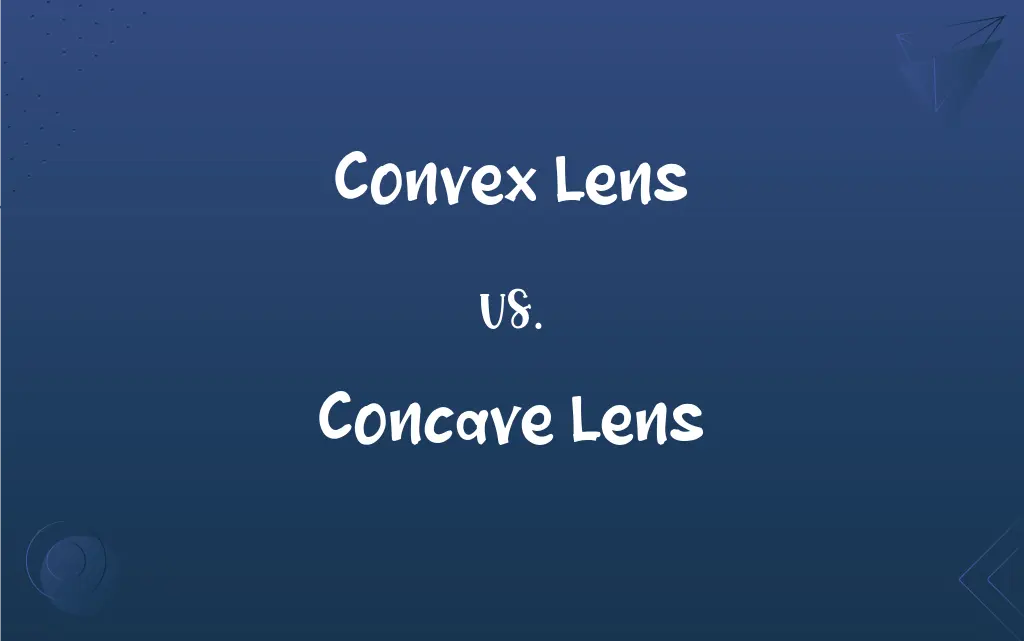Convex Lens vs. Concave Lens: What's the Difference?
Edited by Aimie Carlson || By Harlon Moss || Updated on October 9, 2023
A convex lens bulges outward, converging light rays, while a concave lens is thinner at its center, diverging light rays.

Key Differences
A convex lens, often referred to as a converging lens, exhibits a bulging outward surface, causing parallel rays of light passing through it to converge at a single point known as the focus. Conversely, a concave lens, characterized by its inwardly curved, recessed surfaces, causes parallel light rays passing through it to diverge or spread out. Thus, while a convex lens gathers and focuses light, a concave lens disperses it, each lens manipulating light and subsequently, image perception, in distinctly different ways. It’s vital to recognize that convex lenses tend to produce images that may be either inverted and real or upright and virtual, while concave lenses invariably produce images that are upright and virtual.
Investigating applications in optics, a convex lens is commonly employed in tools and devices, such as microscopes, telescopes, and cameras, where converging light to a focal point is critical to function. In stark contrast, a concave lens is often used in applications like peephole door viewers and eyeglasses for myopia (nearsightedness), where spreading out light rays or creating a reduced, upright virtual image is desired. Therefore, while convex lenses find applications that necessitate magnification and focusing of light, concave lenses are deployed in contexts where a divergence of light rays or a diminution of images is operationally advantageous.
Examining from a lensmaker's and designer’s perspective, the construction and utilization of convex lenses, with their converging properties, are pivotal in systems where light needs to be focused, such as in converging telescopic lenses or camera objectives. On the other hand, concave lenses, with their light-scattering properties, find their place in systems where light is to be spread out or where image size needs to be minimized, providing a vital function in spectacles for correcting myopia or in certain types of optical scanners. As a result, the design considerations for convex lenses often center on optimizing focusing and magnification, whereas for concave lenses, managing divergence and image reduction become paramount.
In the realm of corrective eyewear, a convex lens is typically prescribed to individuals who experience hyperopia or presbyopia, characterized by the eye’s inability to focus on nearby objects, thus necessitating a lens that converges light to aid in forming a clear image on the retina. Conversely, a concave lens is prescribed for myopic individuals, whose eyes focus light from distant objects in front of the retina, requiring a lens that diverges light and pushes the focal point back onto the retina. Thus, in the context of optical correction, convex lenses and concave lenses serve to modify the focal point of light entering the eye, assisting in the formation of clear images on the retina, albeit through converging and diverging mechanisms, respectively.
When exploring lenses in a scientific and experimental context, a convex lens can be utilized to focus light in experiments that require high-intensity light within a small area, such as in focusing sunlight to a point to examine heat effects. In contrast, a concave lens may be used in experiments to explore the scattering of light, such as examining the dispersion patterns of laser light or studying the behavior of light as it diverges. Thus, in scientific investigations, convex lenses become instrumental when the concentration of light is needed, while concave lenses offer utility in studies where the dispersion or diffusion of light is under scrutiny.
ADVERTISEMENT
Comparison Chart
Shape
Bulges outwards
Caves inwards
Behavior of Light Rays
Converges (brings together)
Diverges (spreads out)
Center Thickness
Thicker than edges
Thinner than edges
Typical Use
Magnifying glasses, cameras
Correcting myopia in eyeglasses
Image Produced
Real or virtual (depends on object)
Always virtual and upright
ADVERTISEMENT
Convex Lens and Concave Lens Definitions
Convex Lens
A convex lens converges parallel rays of light.
Telescopes employ a convex lens to focus distant light.
Concave Lens
A concave lens diverges parallel rays of light.
A concave lens causes light rays to spread outward.
Convex Lens
A convex lens is commonly used in optical devices.
Optometrists prescribe eyeglasses with a convex lens to correct hyperopia.
Concave Lens
A concave lens produces only virtual and diminished images.
When viewing an object through a concave lens, it appears smaller.
Convex Lens
A convex lens is a converging lens.
Light rays bend towards each other when they pass through a convex lens.
Concave Lens
A concave lens is a lens with a center thinner than its edges.
Myopic individuals often wear glasses with a concave lens.
Convex Lens
A convex lens is a lens that bulges outward in its center.
The magnifying glass uses a convex lens to enlarge objects.
Concave Lens
A concave lens is a diverging lens.
A concave lens causes light rays to bend away from each other.
Convex Lens
A convex lens can form real or virtual images.
Cameras utilize a convex lens to project real images onto a sensor.
Concave Lens
A concave lens is utilized in certain optical instruments.
Astronomers sometimes use a concave lens to spread light in spectrometers.
FAQs
How does a convex lens affect light?
A convex lens brings light rays together, converging them.
Can a convex lens produce virtual images?
Yes, depending on object placement, a convex lens can produce both real and virtual images.
What is a concave lens?
A concave lens is a lens that is thinner in the center and diverges light rays.
What is a convex lens?
A convex lens is a lens that bulges outward in the center and converges light rays.
Why is a concave lens called a diverging lens?
Because it spreads light rays apart or diverges them.
How does a concave lens affect light?
A concave lens spreads light rays apart, diverging them.
Why is a convex lens called a converging lens?
Because it brings light rays together or converges them.
What is the shape difference between a convex and concave lens?
A convex lens bulges outward, while a concave lens caves inward.
What kind of image does a concave lens produce?
A concave lens always produces a virtual, upright, and diminished image.
Can these lenses be combined in optical systems?
Yes, they can be combined to correct multiple vision problems or in complex optical devices.
Which lens is thicker in the center?
The convex lens is thicker in the center.
Which lens is used in a magnifying glass?
A magnifying glass uses a convex lens.
Which lens can make distant objects appear closer?
A convex lens can make distant objects appear closer when appropriately used.
In which optical devices is a convex lens commonly found?
In magnifying glasses, cameras, and some eyeglasses.
Can a convex lens magnify objects?
Yes, a convex lens can magnify objects when they are placed between the lens and its focal point.
Can both lenses be used in eyeglasses?
Yes, a convex lens corrects hyperopia, while a concave lens corrects myopia.
How does focal length differ between the two lenses?
A convex lens has a positive focal length, while a concave lens has a negative one.
Do both lenses refract light?
Yes, both lenses refract light but in different manners – convex converges, concave diverges.
Where is a concave lens typically used?
In eyeglasses to correct myopia and in some optical instruments.
Does a concave lens magnify objects?
No, a concave lens always produces a diminished image.
About Author
Written by
Harlon MossHarlon is a seasoned quality moderator and accomplished content writer for Difference Wiki. An alumnus of the prestigious University of California, he earned his degree in Computer Science. Leveraging his academic background, Harlon brings a meticulous and informed perspective to his work, ensuring content accuracy and excellence.
Edited by
Aimie CarlsonAimie Carlson, holding a master's degree in English literature, is a fervent English language enthusiast. She lends her writing talents to Difference Wiki, a prominent website that specializes in comparisons, offering readers insightful analyses that both captivate and inform.































































